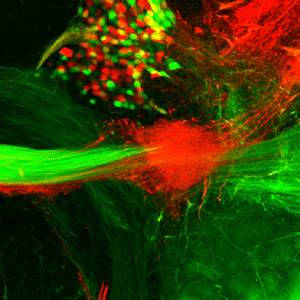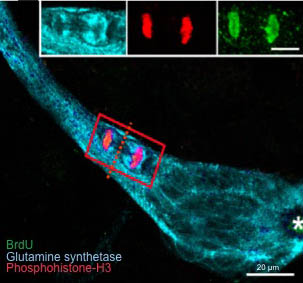Contact Information:
Dr. Barbara S. Beltz
Hallowell Farwell Professor of Neuroscience
Director, Neuroscience Program
106 Central Street
Wellesley College
Wellesley, MA 02481-8203
Office: SC 383
Phone: 781-283-3048 (office)
781-283-3350 (lab)
Fax: 781-283-3642
Beltz Lab homepage
Email: bbeltz@wellesley.edu |
|
|
Education:
| B.A. |
Biology and English, Mount Holyoke College |
| M.A., Ph.D. |
Neuroscience, Princeton University |
| Postdoctoral training |
Neurobiology Department, Harvard Medical School |
back to top
|
|
Wellesley courses currently taught (2009-10):
NEUR 300: Advanced Seminar in Neuroscience
NEUR 306: Principles of Neural Development
NEUR 332: Neuroscience and the Law
back to top
|
|
Affiliations:
Members of the Beltz laboratory, including undergraduate students, actively participate in regional, national and international conferences and organizations: Society for Neuroscience (http://web.sfn.org/), East Coast Nerve Net (http://crab-lab.zool.ohiou.edu/nervenet/), International Society for Neuroethology (http://www.neuroethology.org/). In
addition, we maintain an active affiliation with the Mt. Desert
Island Biological Laboratory (http://www.mdibl.org/) in Bar Harbor, ME, where for many summers we have spent several weeks doing research and working with students.
back to top
|
|
Research Interests:
links to Neuroscience Web site and Beltz Lab website
1. Summary
Regulation of Life-long Neurogenesis
New neurons are born throughout life in the brains of many organisms, including humans. My laboratory’s primary focus is understanding the sequence of events that leads to the production of new nerve cells and the regulatory events that influence this process. Using the crustacean brain as our experimental model, we have identified the primary precursor (stem) cells that divide to produce migratory daughters; these cells travel to proliferation zones where they will divide at least one more time, and their descendants will differentiate into neurons. We have tested how environmental (e.g., day-night cycle; diet), behavioral (e.g., locomotion) and endogenous (hormones; serotonin; nitric oxide) signals result in the selective activation of neuronal and molecular pathways controlling neuronal birth, migration, differentiation and apoptosis. We are particularly interested in the relationship between the nervous and hematopoietic systems, and how circulating cells may interact with neuronal precursors. Students are involved in all phases of this work, which can involve chemical, molecular, immunocytochemical, electrophysiological and behavioral methods. Specific research projects are planned in consultation with each student to insure that the student’s interests as well as the lab’s goals are addressed.
|
 |
| Regions in the crayfish brain are labeled with dextran coupled
with micro-ruby and micro-emerald dyes (see Sullivan and Beltz, 2005 a and b).
|
The tract-tracing dye DiI is used to trace projections from regions in the crayfish brain.
|
2. Current Student Projects
Neishay Ayub (’10) is testing the influence of enriched and deprived environments on the numbers of primary neuronal precursor cells residing in the neurogenic niche, and on the numbers of circulating cells in the blood that label for specific markers. She also is examining whether environment influences the cell cycle time of the primary, secondary (migrating) or tertiary neuronal precursors.
Natalie Matthews (’11) Rachel Kery (’12) and Lindsey Migliore (’11) are collaborating in projects asking whether ablation of hematopoietic tissues influences the numbers of primary precursor cells residing in the neurogenic niche.
Zehra Omer (’10) is examining the effect of lithium on brain serotonin levels using HPLC methods. She is also testing how lithium influences the numbers of primary, secondary and tertiary precursor cells, a project that was initiated by Colleen Kirkhart (’09).
Adrienne Otapalik (’11) is working with Nancy Kolodny in the Chemistry Department to develop MRI methods for tracking iron oxide-labeled cells extracted from the blood in living adult crayfish.
 |
 |
A lineage of at least three generations of precursors produces adult-born neurons in the crayfish brain (left image). A vascular niche contains the primary neuronal precursors, which divide and their daughters migrate towards one of two proliferation zones. Once in the proiferation zones, these secondary precursors divide at least once more before their descendants differentiate into neurons (see Sullivan et al., 2007a). |
All mitotic divisions observed are symmetrical, and both daughters migrate to the proliferation zones (see Zhang et ak, 2009).
|
3. Future Directions
Several lines of investigation have shown that the primary neuronal precursors that reside within a neurogenic niche, and which are functionally analogous to vertebrate stem cells, are not a self-renewing population ( Zhang et al, 2009). Therefore, there must be an external source of cells that can be recruited to the niche and which transform into neuronal precursors. One of our primary interests at the current time is to explore this avenue, by testing the attraction of hematopoietic cells to the niche and their competence to become neuronal precursors.
back to top
|
|
Research Collaborators
Dr. Silvana Allodi, Universidade Federal do Rio de Janiero, Brazil PDF file
Dr. Steffen Harzsch, Universitat Greifswald, Germany PDF file
Dr. Nancy Kolodny, Department of Chemistry, Wellesley College pdf to Brinkley et al., 2005 PDF file
Dr. Edward Kravitz, Neurobiology Department, Harvard Medical School PDF file PDF file
Dr. Eve Marder, Volen Center and Biology Department, Brandeis University PDF file
Dr. David Sandeman, formerly at the School of Biological Sciences,
University of New South Wales, Sydney, Australia PDF
file PDF file PDF file
Dr. Michael Tlusty, Edgerton Lab, New England Aquarium, Boston PDF file
back to top
|
|
Beltz lab members and recent former members (L - R): Jeannie Benton (Research Associate), Neishay Ayub ('10), Natalie Matthews ('11), Yi Zhang (Postdoctoral Fellow), Faith Kim ('09), David Sandeman (Research Scholar), Chindhuri Selvuradai ('10), Colleen Kirkhart ('09), Yi Zhang, Neishay Ayub, Jeremy Sullivan (former Postdoctoral Fellow), and Jeannie Benton.
Selected publications
(see Curriculum Vitae for a complete list; * denotes undergraduate author)
Harzsch S, *Miller J, Benton J, Beltz B (1999) From embryo to adult: Persistent neurogenesis and apoptotic cell death shape the crustacean deutocerebrum. Journal of Neuroscience 19:3472-3485.
Sullivan JM, Benton JL, Beltz BS (2000) Serotonin depletion in vivo inhibits the branching of olfactory projection neurons in the lobster deutocerebrum. Journal of Neuroscience 20:7716-7721.
Beltz BS, Benton JL, Sullivan JM (2001) Transient uptake of serotonin by newborn olfactory projection neurons may mediate their survival. Proceedings
of the National Academy of Science 98:12730-12735.
Sullivan JM, Beltz BS (2001) Development and connectivity of olfactory pathways in the brain of the lobster Homarus americanus. Journal of Comparative Neurology 441:23-43.
Benton JL, Beltz BS (2002)
Patterns of neurogenesis in the midbrain of embryonic lobsters are different from proliferation in the insect and crustacean ventral nerve cord. Journal of Neurobiology 53: 57-67.
Goergen, E, *Bagay LA, Rehm K, Benton JL, Beltz BS (2002) Circadian control of neurogenesis. Journal of Neurobiology 53: 90-95.
Beltz BS, *Kordas K, *LeeMM, *LongJB, BentonJL, SandemanDC (2003) Ecological, evolutionary and functional correlates of sensilla number and glomerular density in the olfactory system of decapod crustaceans. Journal of Comparative Neurology 455: 260-269.
Beltz BS, Sandeman DC (2003) Regulation
of life-long neurogenesis in the decapod crustacean brain. Arthropod Structure and Development 32:39-60.
Sullivan JM, Beltz BS (2004) Evolutionary changes in the olfactory projection neuron pathways of eumalacostracan
crustaceans. Journal of Comparative Neurology 470:25-38.
Wildt M, Goergen EM, Benton JL, Sandeman DC, Beltz BS (2004) Regulation of serotonin levels by multiple light-entrainable endogenous rhythms Journal of Experimental Biology 207:3765-74.
*Brinkley CK, Kolodny NH, Kohler SJ, Sandeman DC, Beltz BS (2005) Magnetic resonance imaging at 9.4 T as a tool for studying neural anatomy in non-vertebrates. Journal of Neuroscience Methods 146:124-132.
Sullivan JM, Beltz BS (2005a) Integration and segregation of inputs to higher-order neuropils in the crayfish brain. Journal of Comparative Neurology 481:118-126.
Sullivan JM, Beltz BS (2005b) Newborn cells in the adult crayfish brain differentiate into distinct neuronal types. Journal of Neurobiology 65: 157-170.
Sullivan JM, Beltz BS (2005c) Adult neurogenesis in the central olfactory pathway in the absence of receptor neuron turnover. European Journal of Neuroscience 22:2397-2402.
Sullivan JM, Benton JL, Sandeman DC, Beltz BS (2007a) Adult Neurogenesis: A Common Strategy Across Diverse Species. Journal of Comparative Neurology 500:574-584.
Beltz BS, Tlusty MF, Benton JL, Sandeman DC (2007) Omega-3 fatty acids upregulate adult neurogenesis. Neuroscience Letters 415:154-8.
Sullivan JM, Sandeman DC, Benton JL, Beltz BS (2007b) Adult neurogenesis and cell cycle regulation in the crustacean olfactory pathway: from glial precursors to differentiated neurons. Journal of Molecular Histology 38:527-542.
Benton JL, Goergen EM, *Rogan SC, Beltz BS (2008) Hormonal and synaptic influences of serotonin on adult neurogenesis. General and Comparative Endocrinology 158:183-190.
Harzsch S, Dircksen H, Beltz BS (2009) Development of pigment-dispersing hormone-immunoreactive neurons in the American lobsters: homology to the insect circadian pacemaker system? Cell and Tissue Research 335:417-429.
Zhang Y, Allodi S, Sandeman DC, Beltz BS (2009) Adult neurogenesis in the crayfish brain: proliferation, migration and possible origin of precursor cells. Developmental Neurobiology 69:415-436.
Sandeman DC, Benton JL, Beltz BS (2009) An identified serotonergic neuron regulates neurogenesis in the crayfish brain. Developmental Neurobiology 69:530-545.
Sullivan JM, *Genco MC, *Marlow ED, Benton JL, Beltz BS, Sandeman DC (2009) Brain photoreceptor pathways contributing to circadian rhythmicity in crayfish. Journal of Biological Rhythms 26:1136-1168.
back to top
|
Curriculum Vitae
back to top
|
|
|

